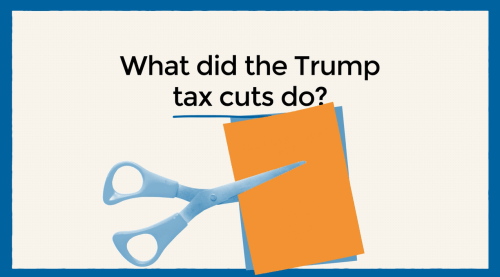In a new series, experts in Economic Studies at Brookings review the state of the economy in 2016 and tell us what to expect in 2017, from Fed rate hikes to the future of the Affordable Care Act.
With the election of Donald Trump as president and the Republicans’ retention of a majority in the Senate and the House, the prospects for big changes in tax policy have increased dramatically. Tax cuts unite almost all factions of the Republican Party. As Speaker Paul Ryan mentioned in October, the plan would be to use parliamentary procedures – a budget resolution followed by reconciliation– to prevent a filibuster and push a proposal through with few, if any, Democratic votes. Whether the actual change is a major structural reform or just a tax cut remains an open question, but it will likely be touted as sweeping reform either way.
The plans put forward by leading Republicans in Congress – the Ryan-Brady plan – and the plan that Trump put forward during the campaign share many features. Both plans, for instance, would slash individual tax rates.
But there are several issues where it might be hard to reach agreement, even among Republicans. Most of them are on the business side. During the campaign, Trump said he would cut the top corporate rate from 35 percent to 15 percent, lower the top rate faced by pass-through entities (sole proprietorships, partnerships, and S corporations) to 15 percent, allow for expensing of investment instead of depreciation, repeal certain business tax expenditures, and impose a one-time tax on existing un-repatriated earnings.
The House plan would abolish the corporate tax altogether and replace it with what is called a “destination-based cash-flow” tax. A classic value-added tax, a national tax on consumption, would tax only wages and business profits. This one is slightly different: It’s a value-added tax with a deduction for wages, so it would only burden business profits. The rate would be 20 percent for corporations and 25 percent for pass-through entities. The plan also includes provisions to make it harder for taxpayers to shift their income from wage earnings to pass-through income. Like all VATs worldwide, the House plan would allow for border-adjustability: revenues from exports would not be taxed, and the cost of imports would not be deductible.
The proposals raise many interesting issues. According to Tax Policy Center and Penn-Wharton Budget Model estimates, the Trump plan would have an initial positive short-term stimulus effect, but the added debt – $7 trillion over the next 10 years – would eventually cause economic growth to decline, and the economy would end up smaller after a decade than without the plan. This is in contrast to Trump’s claim that the plan would be “the most pro-growth…plan put forth perhaps in the history of our country.” The Ryan-Brady plan would lose less revenue than Trump’s proposal, but still would cost several trillion dollars over the next decade. It would raise GDP by 1 percent after a decade, but after two decades, the economy would be smaller than under current law because of the added debt burden. This estimate is consistent with the historical evidence that shows tax cuts do not necessarily spur economic growth.
Under both plans, the benefits are highly skewed towards the very rich, not the middle class (as originally claimed). Even though households in every income quintile would receive a tax cut under Trump’s plan, once the plan is fully phased-in, the lowest quintile would only receive a less than 1 percent increase in after-tax income compared to a 7 percent increase for the top quintile. The gains for the top 1 percent would be even greater at 14 percent (an average gain of more than $300,000). Under the Ryan-Brady plan, the story is broadly similar. However, those in the 60th-95th percentile would experience a drop in after-tax income.
The regressivity of the tax plans would be exacerbated once the tax cuts are actually paid for. Because the government budget is currently on an unsustainable path, any reduction in the projected revenue stream must be made up for, over time, by some combination of new revenues or lower spending. For example, let’s assume that Trump’s tax plan is eventually financed by an equal dollar payment from each tax unit (through an across-the-board reduction in benefits from government spending or a lump-sum tax) or a payment from each tax unit in proportion to their income (though a reasonable combination of spending cuts and progressive tax increases). Under either financing scenario, households in the bottom 80 percent of the income distribution would be worse off relative to current law, while the top quintile would still experience a net increase in after-tax income.
Uncertainty about the tax cut is high, though. The tax cuts could end up being much bigger than advertised. In both the Trump and the House Republican plans, there are a number of “pay-fors” – such as cuts in itemized deductions, removal of the deduction for interest payments, and taxes on imports – that normally one party does not implement by itself. Tax increases like this place a political target on those in power, especially given the Republicans’ unified control. On the other hand, deficit hawks might balk at the overall size of the cuts, and push for a smaller revenue loss than the current plans call for.
Several questions also surround the status of international trade as a result of these plans. Many legal experts think the House plan violates existing trade laws, although there may be ways to design the tax that skirt the rules. In addition, despite economists’ assurances that border adjustability will lead to exchange rate adjustments and thus will not affect trade balances, many people believe that the Ryan-Brady plan will reduce the trade deficit (if they support the tax) or raise the price of imports (if they oppose the tax).
Tax changes may be an idea whose time has come politically – given the forthcoming Republican unified control and Trump’s emphasis on reducing the trade deficit. Regardless which plan most closely resembles the eventual deal between Trump and Congress, the U.S. tax system may look very different by the end of next year.




Commentary
Op-edWith Republicans in charge, 2017 could finally bring big changes in tax policy
December 22, 2016